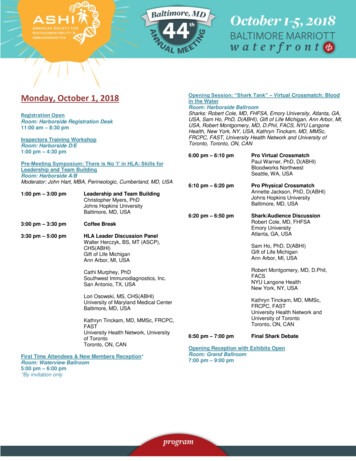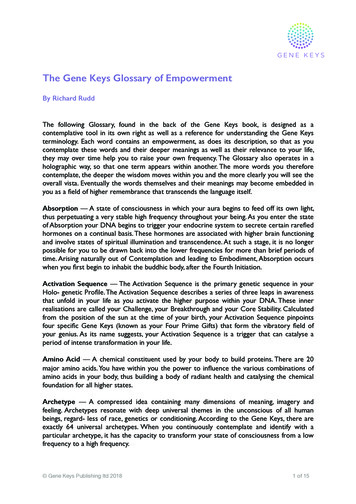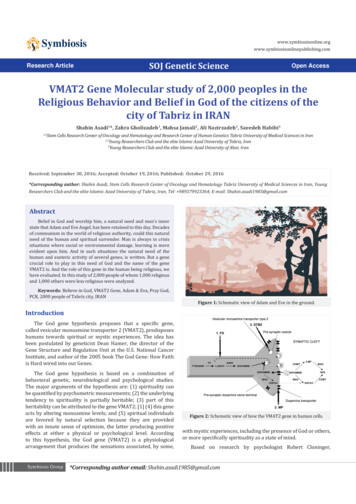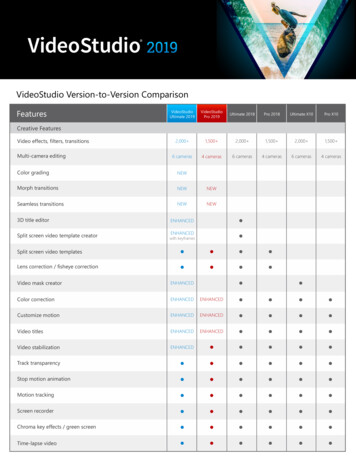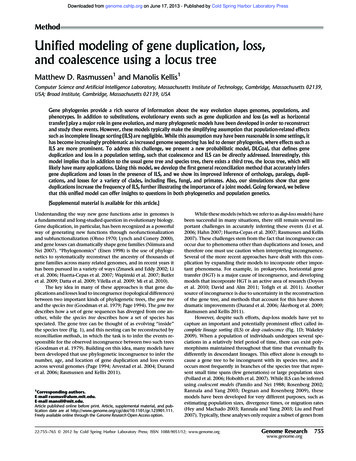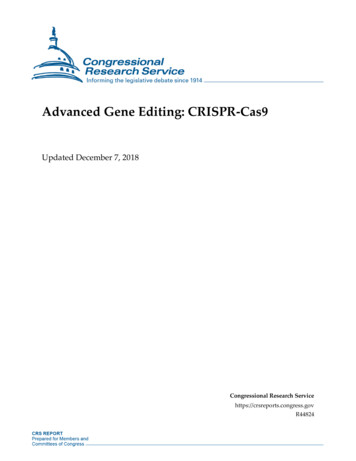
Transcription
Advanced Gene Editing: CRISPR-Cas9Updated December 7, 2018Congressional Research Servicehttps://crsreports.congress.govR44824
Advanced Gene Editing: CRISPR-Cas9SummaryScientists have long sought the ability to control and modify DNA—the code of life. A geneediting technology known as CRISPR-Cas9 offers the potential for substantial improvement overother gene editing technologies in that it is simple to use and inexpensive and has a relativelyhigh degree of precision and efficiency. These characteristics have led many in the scientific andbusiness communities to assert that CRISPR-Cas9 will lead to groundbreaking advances in manyfields, including agriculture, energy, ecosystem conservation, and the investigation, prevention,and treatment of diseases.Over the next 5 to 10 years, the National Academy of Sciences projects a rapid increase in thescale, scope, complexity, and development rate of biotechnology products, many enabled byCRISPR-Cas9. Concomitant with the promise of potential benefits, such advances may pose newrisks and raise ethical concerns. For example, a Chinese researcher recently claimed that he hadcreated the first genetically engineered human babies. According to the researcher, he usedCRISPR-Cas9 to disable a gene that will make it harder for the twin girls, who were born inNovember 2018, to contract human immunodeficiency virus (HIV). The as yet unsubstantiatedclaim has sparked outrage and ethical debates by the international scientific community andothers. Prior use of CRISPR-Cas9 gene editing in human embryos was generally limited to nonviable embryos, in part, to address ethical concerns such as the fact that the genetic change wouldaffect not only the immediate patient, but also future generations who would inherit the change.Additionally, CRISPR-related approaches (gene drives) are being considered to reduce oreliminate the mosquito that serves as the primary vector for the transmission of Zika or malaria,thereby improving public health. Some scientists and environmental groups have raised ethicalquestions and expressed concerns about the unintended ecological consequences of eliminating aspecies or introducing a genetically modified organism into an open environment.Some experts assert that the current system for regulating biotechnology products—theCoordinated Framework for the Regulation of Biotechnology—may be inadequate, with thepotential to leave gaps in oversight. Regulatory gaps may lead to increased uncertainty that couldaffect the development of future biotechnology products or a loss of public confidence in theability of regulators to ensure that such products are safe.In the 116th Congress, policymakers may want to examine the potential benefits and risksassociated with the use of CRISPR-Cas9 gene editing, including the ethical, social, and legalimplications of CRISPR-related biotechnology products. Congress also may have a role to playwith respect to regulation, research and development, and economic competitiveness associatedwith CRISPR-Cas9 gene editing and future biotechnology products.Congressional Research Service
Advanced Gene Editing: CRISPR-Cas9ContentsIntroduction . 1Overview . 1What Is CRISPR-Cas9? . 1Gene Editing. 2How CRISPR-Cas9 Technology Works . 2What Are Gene Drives? . 3CRISPR-Cas9 Market Projections, Investments, and R&D Spending . 4Market Projections . 4Private Investments . 5Federal R&D Funding and Scientific Publications . 8The Coordinated Framework for the Regulation of Biotechnology . 9Application Areas and Issues for Consideration. 11Human Health and Medicine . 12Diabetes . 12Malaria . 12Sickle Cell Disease . 13Duchenne Muscular Dystrophy . 13Antibiotic Resistance . 14Biomedical and Clinical Research: Heritable Versus Non-Heritable Changes . 14U.S. Regulation and Oversight of Biomedical and Clinical Research . 17Ethical Considerations . 19Agricultural Development . 21U.S. Regulation and Oversight of Agricultural Biotechnology . 22Social Acceptance and Ethical Concerns . 25CRISPR-Cas9 and International Agriculture . 25Industrial Biotechnology . 27Ecosystem Management and Conservation. 27Gene Drives and Environmental Concerns . 28U.S. Regulation and Oversight of Gene Drives . 28Social Acceptance and Ethical Concerns . 30International Regulation of Genetically Modified Organisms . 32Basic Research . 33National Security Concerns. 34FiguresFigure 1. CRISPR-Cas9 Gene Editing Technology . 3Figure 2. How a Gene Drive Works . 4TablesTable 1. NIH Funding for CRISPR-Related Research, FY2011-FY2018 . 8Table 2. Number of CRISPR-Related Scientific Publications, 2011-2018 . 9Congressional Research Service
Advanced Gene Editing: CRISPR-Cas9ContactsAuthor Information. 35Congressional Research Service
Advanced Gene Editing: CRISPR-Cas9IntroductionGenes, the fundamental code of life, are written in DNA (deoxyribonucleic acid). Before DNAwas even discovered, humans sought to manipulate genes through selective breeding. Since itsdiscovery, scientists, science fiction writers, philosophers, and others have speculated on theimplications of being able to modify DNA. Over the last half century, billions of dollars andimmeasurable effort have been devoted to understanding, characterizing, and controlling DNA.This report describes a gene editing technology, known as CRISPR-Cas9, with the potential torevolutionize genetic engineering and the biotechnology industry. The report then providesinformation on the potential economic benefits of the technology and identifies some issues forcongressional consideration, including the regulation of current and future products, nationalsecurity concerns, and ethical and societal issues surrounding the use of the technology.OverviewWhat Is CRISPR-Cas9?CRISPR-Cas9 is a gene editing technology that offers the potential for substantial improvementover other gene editing technologies1 in ease of use, speed, efficacy, and cost. Thesecharacteristics led Science magazine to name CRISPR-Cas9 gene editing technology“Breakthrough of the Year” in 2015.2 Many in the scientific, engineering, and businesscommunities believe that CRISPR-Cas9 may offer revolutionary advances in the investigation,prevention, and treatment of diseases; understanding of gene function; improving crop yields anddeveloping new varieties; production of chemicals used in biofuels, adhesives, and fragrances;and control of invasive species.3CRISPR is an acronym for “clustered regularly interspaced short palindromic repeats,” which areunique DNA sequences found in some bacteria and other microorganisms. These sequences,along with the genes that are located next to them, known as CRISPR-associated or Cas genes,form an immune system that protects against viruses and other infectious DNA. The CRISPRsystem identifies, cuts, and destroys foreign DNA. Researchers have identified five differenttypes of CRISPR systems. The most studied CRISPR system is associated with the Cas9 proteinand is known as CRISPR-Cas9. During 2012 and 2013, researchers modified CRISPR-Cas9 toserve as an effective and efficient technology for editing the genomes4 of plants, animals, andmicroorganisms. Since then, CRISPR-Cas9 has been used to modify the genomes of a variety ofspecies—ranging from mice and fruit flies to corn and yeast. Many in the scientific communitybelieve CRISPR-Cas9 has shifted the paradigm with its simplicity and low cost relative to othermethods of gene editing—removing barriers to widespread adoption and creating new researchopportunities.5 This report focuses on the use of CRISPR-Cas9 as a gene editing technology,1For example, zinc finger nucleases (ZFNs) and transcription activator-like effector-based nucleases (TALENs).John Travis, “Making the Cut: CRISPR Genome-Editing Technology Shows Its Power,” Science, vol. 350, no. 6267,December 2015, p. 1456.3 See, for example, Heidi Ledford, “CRISPR, the Disruptor,” Nature, vol. 522, no. 7554, June 3, 2015, pp. 20-24.4 A genome is an organism’s complete set of DNA, including all of its genes.5 Heidi Ledford, “CRISPR, the Disruptor,” Nature, vol. 522, no. 7554, June 3, 2015, pp. 20-24.2Congressional Research ServiceR44824 · VERSION 5 · UPDATED1
Advanced Gene Editing: CRISPR-Cas9which is sometimes referred to as CRISPR in the report. However, other CRISPR systems arecurrently in development and use.6Despite this promise, technical challenges to realizing the full potential of CRISPR-Cas9 remain.Researchers largely agree that efficiently delivering the technology to particular cells, tissues, ororgans, and reducing off-target activity (i.e., the number of unintended genetic changes) areamong the most pressing challenges. Off-target activity may increase the risk of cancer, and thusimproved delivery and specificity are especially important for the development of gene therapyapplications.7 Scientists are investigating ways to overcome these challenges and improveCRISPR-Cas9.Gene EditingFor decades, scientists have altered genes using radiation or chemicals. These methods produceunpredictable results. The invention of recombinant DNA technology in the 1970s allowedscientists to insert new DNA into genes in a directed way, but inserting a specific gene orsequence within the genome remained technically challenging and imprecise.Gene editing is a newer technique that is used to make specific and intentional changes to DNA.8Gene editing can be used to insert, remove, or modify DNA in a genome. All gene editingtechnologies involve an enzyme known as a nuclease for cutting the DNA, in addition to atargeting mechanism that guides the enzyme to a specific location on the DNA strand (i.e., a genewithin the genome). Gene editing has traditionally involved the insertion, removal, ormodification of a single gene, but with CRISPR-Cas9 multiple genes can be targetedsimultaneously. Such multi-gene editing is generally referred to as genome editing.How CRISPR-Cas9 Technology WorksCRISPR-Cas9 is a gene editing technology that uses a combination of (1) an enzyme that cutsDNA (Cas9, a nuclease) and (2) a guiding piece of genetic material (guide RNA) to specify thelocation in the genome. Generally, the guide RNA targets and binds to a specific DNA sequence,and the attached Cas9 enzyme cleaves both strands of DNA at that site. This cut can be used toinsert, remove, or edit the DNA sequence. The cut is then repaired and the changes incorporated(Figure 1). This specificity of modification is one feature that differentiates CRISPR-Cas9 frompredecessor genome editing systems.Scientists can create a guide RNA corresponding to almost any sequence within an organism’sgenome. This flexibility allows for the potential application of the technique to a very wide rangeof genomes, including microorganisms, animals, or plants. If the sequence of the desired target orgene (and its function) is known, in theory, CRISPR-Cas9 could be used to alter the function of acell or organism.The basic CRISPR-Cas9 technology, specifically the Cas9 nuclease, has also been adapted byresearchers to allow for additional modifications to the genome beyond the cutting of both strandsof the DNA. For example, researchers have adapted Cas9 so that it can be used to change a single6Other CRISPR systems refers to CRISPR gene editing technologies that use Cas-associated proteins other than Cas9.Prashant Mali, Kevin M. Esvelt, and George M. Church, “Cas9 as a Versatile Tool for Engineering Biology,” NatureMethods, vol. 10, no. 10, October 2013, p. 962.8 For a more detailed description, see ting.7Congressional Research ServiceR44824 · VERSION 5 · UPDATED2
Advanced Gene Editing: CRISPR-Cas9base9 in a gene (base editing), cut a single strand of DNA, or activate or repress the expression ofa gene (i.e., increase or decrease the production of a molecule, typically a protein).10What Are Gene Drives?CRISPR-Cas9 has led to recent breakthroughsin gene drive research. A gene drive is asystem of biasing inheritance to increase thelikelihood of passing on a modified gene.Offspring inherit one copy of each gene fromits parents. Normally, this limits the totalincidence of mutations over generations(Figure 2). Gene drive components cause themodified DNA to copy itself into the DNAfrom the unmodified parent. The result is thepreferential increase in a specific trait fromone generation to the next and, in time,possibly throughout the population. CRISPRCas9 has allowed researchers to moreeffectively insert a modified gene and thegene drive components. Gene drives havebeen suggested as a way to eliminate orreduce the transmission of disease, eradicateinvasive species, or reverse pesticideresistance in agriculture. The self-propagatingnature of gene drives is also accompanied byconcerns (described later in the report).Figure 1. CRISPR-Cas9 Gene EditingTechnologySource: “What Is CRISPR-Cas9?,” as9.Note: Image credit: Genome Research Limited.9DNA consists of four types of bases: adenine (A), thymine (T), guanine (G) and cytosine (C). The order, or sequenceof these bases, in part, determines the phenotype or observable traits of an individual.10 For a more technical description of how CRISPR-Cas9 can be used to modify or alter the genome nal Research ServiceR44824 · VERSION 5 · UPDATED3
Advanced Gene Editing: CRISPR-Cas9CRISPR-Cas9 Market Projections, Investments, andR&D SpendingCRISPR-Cas9 technology is still in its infancy, with many of the hoped-for applicationspotentially years in the future. However, the interest, efforts, and investments of the industrial andfinancial communities suggest the potential economic and other societal benefits are substantial.Among the early indicators of the potential value of CRISPR-enabled products are fees beingpaid to license CRISPR patents, investments in firms with potential interests in CRISPRintellectual property, the type of companies investing in CRISPR research, and early applications.This section discusses recent projections made by market research firms, select privateinvestments, federal research and development funding, and statistics on scientific publications.Figure 2. How a Gene Drive WorksSource: read-their-wings.Market ProjectionsA number of research firms have published market projections for gene editing, includingCRISPR-Cas9 and other technologies. Application areas include human therapeutics, researchtools, crops, livestock, yogurts, cheeses, and more.Congressional Research ServiceR44824 · VERSION 5 · UPDATED4
Advanced Gene Editing: CRISPR-Cas9 In August 2018, Ireland-based Research and Markets estimated that the globalmarket for gene editing will grow at a compound annual growth rate (CAGR) of33.26% from 551.2 million in 2017 to 3.087 billion in 2023.11 An earlier reportprojected that the North American market will account for the largest share of thegene editing market due to “increasing awareness of technology, proximity ofcompanies, and early adoption of latest treatments.” Asia was expected to be thesecond largest market, due to “increasing government funding of research,economic prosperity, early adoption of latest technology and the relaxedregulatory environment.” The European market was projected to be the thirdlargest market, hampered by “the stringent regulatory environment and slowgrowth due to the economic crisis.”12India-based Markets and Markets estimated that the global market for geneediting will increase from 3.19 billion in 2017 to 6.28 billion in 2022, a CAGRof 14.5%. CRISPR technology was expected to be the largest and fastest-growingsegment of this market in 2017.13Zion Market Research estimated that the CRISPR gene editing market in 2017was 477 million and projected that it will reach 4.271 billion by 2024, a CAGRof 36.8%.14A February 2017 projection by the U.S.-based market research firm Grand ViewResearch anticipates the global market for gene editing will reach 8.1 billion by2025.15Private InvestmentsPrivate investments are a commonly used metric for assessing the economic potential of atechnology. Investments are being made by and in companies of varying size and technologymaturity that are conducting CRISPR research. In addition, these companies are engaging in awide range of partnerships. Here are several examples of recent investments in CRISPR-focusedgene editing firms: Editas Medicine (headquartered in Cambridge, MA) raised approximately 97.5million in its February 2016 initial public offering. In follow-on offerings inMarch and December 2017, Editas raised approximately 96.7 million and 57.2million, respectively. In January 2018, the company completed at-the-marketofferings and received net proceeds of approximately 48.5 million.16 The firmResearch and Markets, “CRISPR Market - Forecasts from 2018 to 2023,” August xx35w/global crispr?w 512 Research and Markets, “Genome Editing Global Market-Forecast to 2022,” September 73wl/genome editing.13 Markets and Markets, “Genome Editing/Genome Engineering Market Worth 6.28 Billion USD by 2022,” November2017, nome-editing-engineering.asp.14 Zion Market Research, “Global CRISPR Genome Editing Market Will Grow USD 4,271.0 Million by 2024,” August2018, search.html.15 Grand View Research, “Genome Editing Market Size to Reach 8.1 Billion by 2025,” February e/global-genome-editing-market.16 Security and Exchange Commission, EDGAR database, Editas Medicine, 10-Q, filed November 8, ressional Research ServiceR44824 · VERSION 5 · UPDATED5
Advanced Gene Editing: CRISPR-Cas9 has licensed CRISPR and other gene editing patent rights from the BroadInstitute, the Massachusetts Institute of Technology (MIT), Harvard University,and others.17 As of November 15, 2018, the company’s market capitalization was 1.34 billion.18 In March 2017, Editas reportedly entered into an agreement withIrish pharmaceutical company Allergan under which Editas was to receive a 90million up-front payment for an option to license up to five preclinical programstargeting eye disease.19 Editas has also partnered with Juno Therapeutics forcancer-related research using CRISPR; under the terms of the agreement, Junowas to pay Editas an initial payment of 25 million and up to 22 million inresearch support for three programs over five years.20 Editas has also engaged ina three-year research and development (R&D) collaboration deal with SanRaffaele Telethon Institute for Gene Therapy to research and develop nextgeneration stem cell and T-cell therapies for the treatment of rare diseases.21CRISPR Therapeutics AG (headquartered in Basel, Switzerland, with R&Doperations in Cambridge, MA), a firm founded by early CRISPR pioneerEmmanuelle Charpentier, has raised a total of almost 140 million, including a 38 million B-series round of financing in June 2016.22 The company raised anadditional 56 million in its October 2016 initial public offering, followed by 122.6 million in January 2018 and 187.6 million in September 2018 insubsequent offerings. In addition, in August 2016, CRISPR Therapeutics andpharmaceutical company Bayer AG founded Casebia Therapeutics, a jointresearch venture “to discover, develop and commercialize new breakthroughtherapeutics to cure blood disorders, blindness, and congenital heart disease.”Bayer stated that it will be providing at least 300 million for R&D by the jointventure and that it had taken a 35 million equity stake in CRISPRTherapeutics.23 CRISPR Therapeutics also has collaboration and jointdevelopment agreements with Boston-based Vertex Pharmaceuticals to useEditas Medicine asserts that it owns “certain rights under 24 U.S. patents, 62 pending U.S. patent applications, fourEuropean patents and related validations, 35 pending European patent applications, 5 pending [Patent CooperationTreaty] applications, and other related patent applications in jurisdictions outside of the United States and Europe.”Editas Medicine, Securities and Exchange Commission 10-K filing for the year ending December 31, 64/000155837016004455/edit-20151231x10k.htm.18 Google Finance, “Editas Medicine, Inc.,” accessed on November 15, 2018, https://www.google.com/finance?q NASDAQ:EDIT.19 Max Stendahl, “Latest Editas Research Pact Could Be Worth up to 1 Billion,” Boston Business Journal, March 22,2017, tml;Allergan, plc, “Allergan and Editas Medicine Enter into Strategic R&D Alliance to Discover and Develop CRISPRGenome Editing Medicines for Eye Diseases,” press release, March 14, 2017, .20 Juno Therapeutics, Inc., “Juno Therapeutics and Editas Medicine Announce Exclusive Collaboration to Create NextGeneration CAR T and TCR Cell Therapies,” press release, May 27, 2015, http://ir.editasmedicine.com/phoenix.zhtml?c 254265&p irol-newsArticle&ID 2125229.21 Editas Medicine, Inc., “Editas Medicine Announces Scientific Multi-Year Collaboration with Fondazione Telethonand Ospedale San Raffaele,” press release, June 28, 2016, http://ir.editasmedicine.com/phoenix.zhtml?c 254265&p irol-newsArticle&ID 2189488.22 CRISPR Therapeutics AG, “CRISPR Therapeutics Raises Additional 38M as Part of Series B Financing,” pressrelease, June 24, 2016, releases-2016-06-24.php.23 Prepared remarks of Marijn Dekkers, Chairman of the Board of Management, Bayer AG, February 25, /A7GCKX-Address-by-Dr-Marijn-Dekkers?Open&parent Speeches&ccm 040,17Congressional Research ServiceR44824 · VERSION 5 · UPDATED6
Advanced Gene Editing: CRISPR-Cas9 CRISPR-Cas9 to discover and develop potential new treatments aimed at theunderlying genetic causes of human disease. CRISPR Therapeutics and Vertexhave reportedly launched the first in-human clinical trial of CRISPR genomeediting technology sponsored by U.S. companies. The trial is testing anexperimental therapy for the blood disorder β-thalassemia in Regensburg,Germany. As of November 15, 2018, the company’s market capitalization was 1.89 billion.24Caribou Biosciences, Inc. (headquartered in Berkeley, CA), a firm founded byJennifer Doudna and other scientists from the University of California, Berkeley,based on an exclusive license to the CRISPR work of that university and theUniversity of Vienna, raised 30 million in private financing in May 2016.25Examples of other efforts focused on CRISPR technology and the development, application, andcommercialization of CRISPR-enabled products include the following: The Parker Institute for CancerImmunotherapy, a non-profitBroad Institute’s Restrictions onorganization formed in April 2016CRISPR Licensingwith a 250 million grant from theThe Broad Institute prohibits the use of the licensedParker Foundation, agreed to sponsorCRISPR technology forthe first in-human clinical trials of gene drive;CRISPR-enabled technology targeting the creation of plants that produce sterile seedsthree types of cancer. The trial, led by(use in naturally sterile plants is not prohibited);the University of Pennsylvania, willanduse CRISPR-modified T-cells, a part the modification of tobacco for any use other thanof the human immune system, to treatin the context of a model organism for researchnot directed to the commercialization of tobacco,myeloma, melanoma, and sarcoma.and for the manufacture of non-tobacco productsThe trial has been approved by the(e.g., therapeutic proteins).National Institutes of Health’sRecombinant DNA AdvisoryCommittee and is awaiting approval from review boards at the centers where thetrials are to be held as well as the Food and Drug Administration. The trial wasinitially expected to commence in 2017, but is still awaiting final approval.26In September 2016, agrochemical and agricultural biotechnology corporationMonsanto secured a worldwide non-exclusive license agreement for agriculturalapplications of CRISPR technology from the Broad Institute.27 With respect to itsintended uses, Monsanto stated, “Genome-editing technology is complementaryGoogle Finance, “Crispr Therapeutics AG,” accessed on April 17, 2017, https://www.google.com/finance?q NASDAQ:CRSP.25 Caribou Biosciences, Inc., http://cariboubio.com/about-us/origins; Caribou Biosciences, Inc., “Caribou BiosciencesRaises 30 Million in Series B Funding,” press release, May 16, 2016, nding.26Preetika Rana, Amy Dockser Marcus, and Wenxin Fan, “China, Unhampered by Rules, Races Ahead in Gene-EditingTrials,” The Wall Street Journal, January 21, 2018, 27 The Broad Institute is a collaboration between the Massachusetts Institute of Technology and Harvard Universityfocused on the use of genomics to advance human health. The Broad Institute has been awarded the first patent onCRISPR-Cas9 in the United States; however, the University of California has filed an appeal to overturn the decision.24Congressional Research ServiceR44824 · VERSION 5 · UPDATED7
Advanced Gene Editing: CRISPR-Cas9 to our ongoing discovery research and provides an incredible resource to furtherunlock our world-leading germplasm and genome libraries.”28Calyxt, Inc. (formerly Cellectis Plant Sciences, Inc., headquartered in NewBrighton, MN), has exclusive rights to a group of patents owned by theUniversity of Minnesota for engineering plant genomes with a focus on productssuch as low trans-fat soybean oil, cold storable potato, gluten reduced wheat, andlow saturated canola oil for the food and agriculture industries.29Federal R&D Funding and Scientific PublicationsThe potential of CRISPR-Cas9 gene editing is further reflected in the rapid increase in CRISPRrelated federal research funding and scientific publications. As shown in Table 1, NIH fundingfor CRISPR-related research grew from more than 5 million in FY2011 to 1.1 billion inFY2018. Similarly, the number of CRISPR-related scienti
Dec 07, 2018 · Gene editing is a newer technique that is used to make specific and intentional changes to DNA.8 Gene editing can be used to insert, remove, or modify DNA in a genome. All


